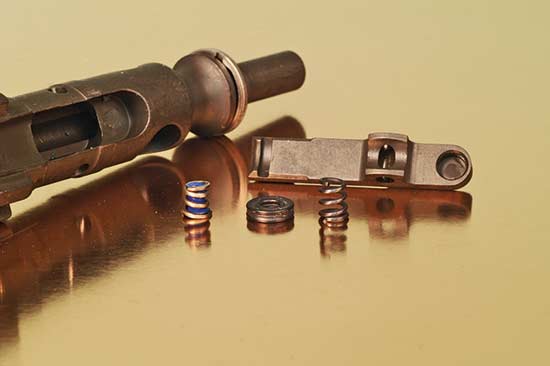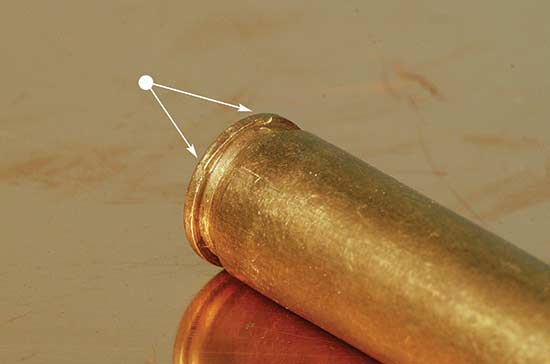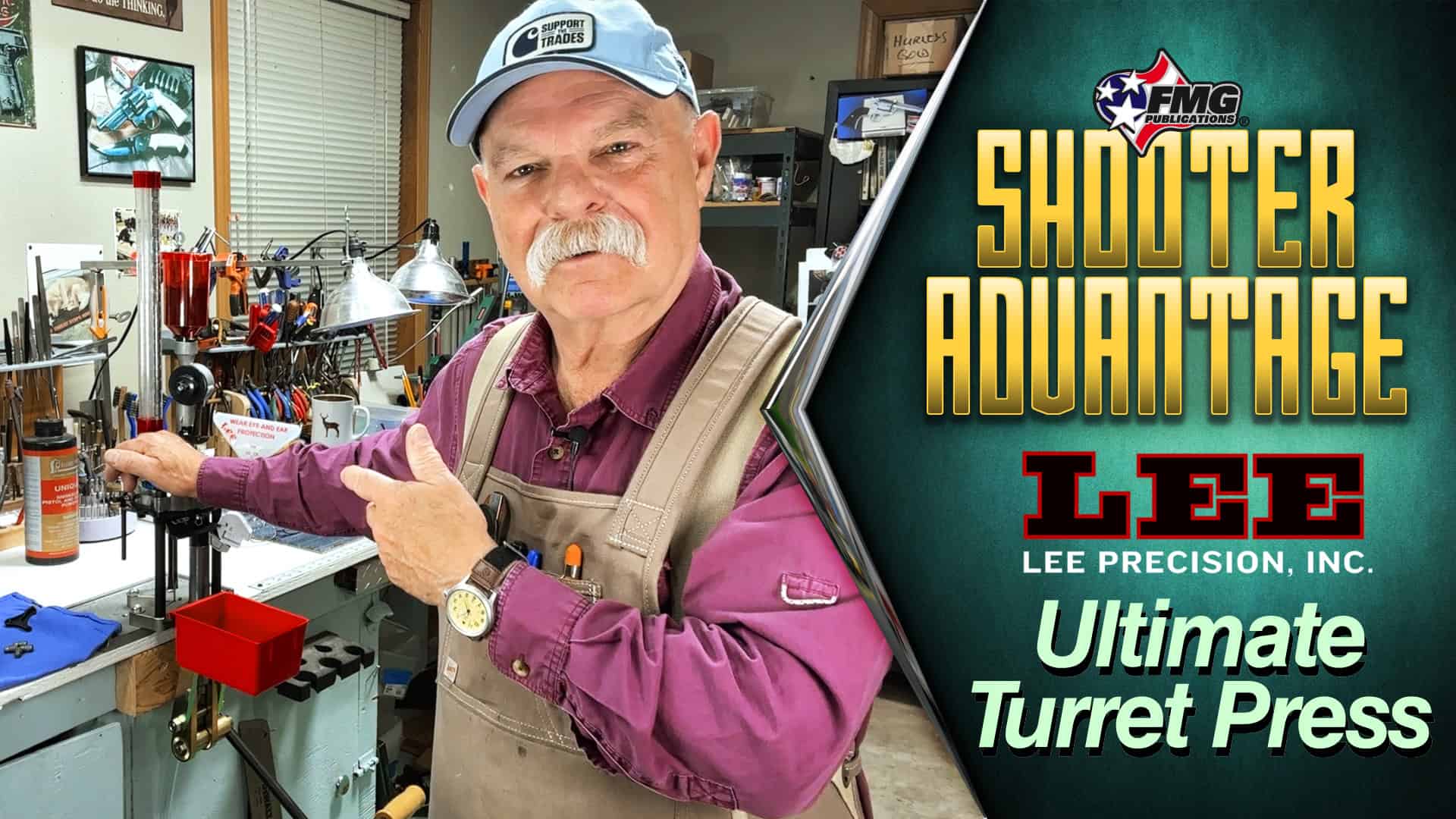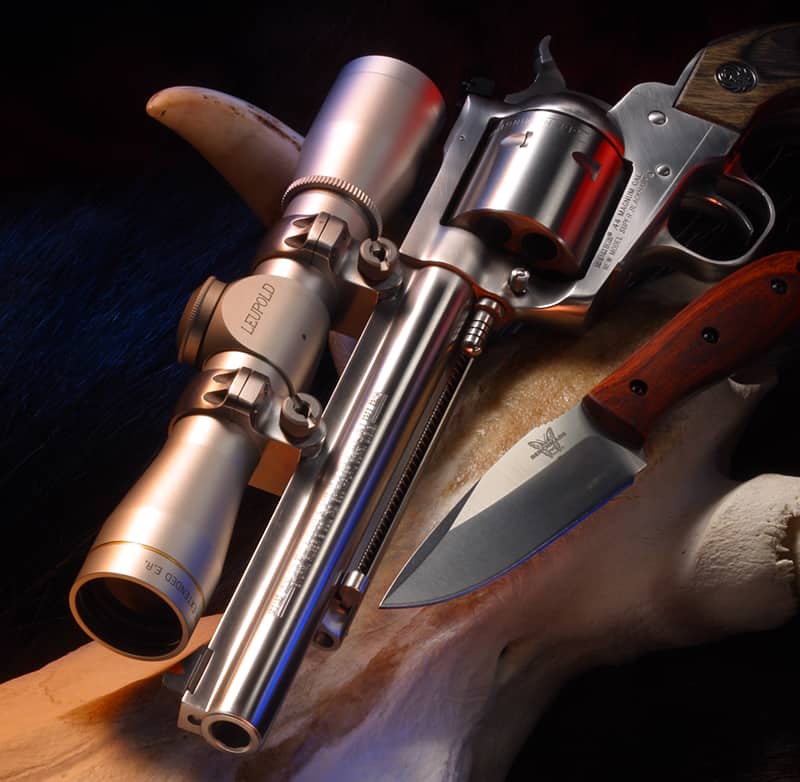Extraction Is Essential
It’s Only “Self Loading” If The Fired Case Comes Out…

On left is an extractor spring removed from a new commercial bolt. It already had a
trendy phenolic insert installed. Center is a “D-Fender” insert that fits over a stock spring
and increases tension 4X. Inserts can help coax out a reluctant case, but they’re not a cure.
On right is a chrome silicon spring from DavidTubb.com. It’s about double the tension of a stock
spring. It’s not so much for the increased grip but because they just don’t break. Stock springs can and will.
Common AR function problems are failures to feed the next round and failures to extract the fired case. Aside from something like a trigger malfunction, those two are pretty much the “it” with virtually all semi-auto function issues. Let’s focus on extraction malfunction.
There are two components involved in getting a spent case out of an AR: the extractor and the ejector. The first pulls the spent case out of the chamber as the bolt retracts after firing. Concurrently, the ejector pushes forward on the left edge of case angling the case body right, toward the ejection port. Ultimately, these pieces/parts combine to loft the spent case out and clear of the action.
The Claw
The extractor on an AR is a common-form “claw” that hooks into the groove between the case rim and the case body. It’s spring-loaded so there’s tension securing its grip. When a round is chambered the extractor contacts and then rides over the case head to clip into the rim.
When an extractor won’t extract, it’s often not the fault of the piece itself. Unless the spring breaks or has weakened to the point the tension it imparts is very low, the reason a spent case is staying inside the upper most usually has to do with tasking the extractor beyond its capacity for duty. Lemmee ’splain…
The failure symptom in mind here is when a bolt/carrier assembly retracts after firing but doesn’t bring the case out with it. Or it doesn’t bring the case out far enough, fast enough to let the ejector and port function together to pitch it into the great outdoors. What’s happened in the first instance—case stays in the chamber—is the extractor has slipped the case rim and lost its grip. Some think the answer is more grip. That’s why the extra-strength “tensioner” type additions are popular. (I’m not a fan.)
If there’s some progress toward extraction, but, as said, it’s incomplete, it’s then usually by reason the bolt carrier lost its drive. It ran out of steam yanking the case free. The bolt carrier assembly also won’t likely have retracted adequately far enough to activate the bolt stop, so will be sitting back home closed, or halfway closed on a half-ejected case.
Gas?
When a round fires, the case swells to the limits of the chamber and the case body adheres to the chamber walls. That’s necessary. The case seals the chamber so all the burning propellant goes forward, in the right direction. Depending on the “timing” of the retraction of the case body back to near-to-normal dimensions and the bolt unlocking, the case can still be swelled up a might too much when the bolt carrier starts to retract and the extractor is supposed to bring the case along with it.
There is always at least some pressure contained within a case when the action begins to function, and, again, the question is how much, and for how long? As always (always) keep in mind we’re talking about milliseconds, and one or two can define “not enough” or “too much.” If there were no gas pressure latent then the gun wouldn’t function at all (and that’s why a freshly-spent case from a semi-auto will raise a blister and one from a bolt-gun is cool to the touch).
So. If the case is not free to move then the extractor is tugging against an immovable or at least unwilling-to-move object. Pop. Loses its grip. Or, POP, can even yank-break a chunk out of the case rim. Either way, the case isn’t going anywhere in any way we want it to. This is the root cause of both symptoms described.
When solving any function problem, start with the simple view first (make sure it’s plugged in before calling an electrician). First make sure the cases have been sized correctly! If they’re hard to chamber then they’re going to be hard to extract. Only, and always, use a full-length sizing die. Next check chamber condition. A rough or dirty chamber (which is also rough) may be detaining extraction. Clean the chamber if it’s dirty. Polish it if it’s rough. Many factory and ready-made replacement-barrel chambers are rough because they weren’t finished like they should be, and they should always have been polished. I polish the chambers on every AR-15 I build.
But the major cause of extraction failures is too dang much gas pressure within the system. An AR-15 uses a “direct impingement” gas system: gas goes through the barrel port, into a fixed volume gas tube, into the bolt carrier key, and kicks back the bolt carrier assembly. Too much pressure too soon means the “works” work regardless of whether we want it to “work” then or not. In this instance, again, the case is not likely to budge because it’s literally stuck to the chamber. The solution is to reduce the amount of gas pressure within the system. That’s at least another article. That’s why, by the way, it’s almost always carbine-length systems exhibiting these “over-gassed”-induced failures, not rifles.
Unless a handloader is experimenting with light loads, an extraction failure is rarely due to insufficient gas pressure within the gas system. Unless there’s a gas leak… More about this on down the line.
The preceding is a specially adapted excerpt from a forthcoming book, The Practical AR15, by Glen Zediker and Zediker Publishing. For more information, check out www.ZedikerPublishing.com or www.BuyZedikerBooks.com.





